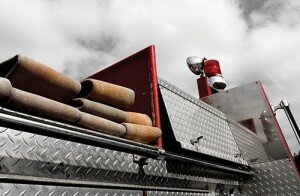 In the annals of local history there are many things which are better forgotten than remembered. There are others which deserve permanent recall. The late Conyers Fire Department, while now as extinct as the Dodo bird, is one of the latter.
In the annals of local history there are many things which are better forgotten than remembered. There are others which deserve permanent recall. The late Conyers Fire Department, while now as extinct as the Dodo bird, is one of the latter.
The earliest information I have found pertaining to any organized fire prevention effort in Conyers I extracted from the University of Georgia archives’ Sanborn Fire Maps. The map of 1884 shows the railroad depot as being where the “Dinky” engine is now parked.
Across the tracks and behind the Moulton building was a “fire and bell watch tower”. Now assuredly there were organized arrangements for fire protection, but I don’t find information about it. I have a few years on me, but I don’t go back to the time of horse-drawn fire engines. And Conyers probably had one. I do go back to the era when horses would have been more reliable than the fire truck we had. The fire truck of my earliest recollection, in the late 1930s and early 1940s, was certainly impressive enough for me.
It was plenty red with ladders, hoses, chrome, and a big silver hand-cranked siren mounted on the right side of the windshield, which I have forever badly wanted to crank up to full volume. I would have happily traded my school lunch money for a year for the privilege.
The fire department was located in the Railroad Street side of the old City Hall on Commercial Street. There was a general alarm siren mounted atop the building now housing Evans Pharmacy. That alarm was triggered by the city policeman also stationed at the city hall building. The alarm signaled the volunteer firemen to report to the fire station pronto.
It undoubtedly replaced the bell atop the aforementioned “fire and watch tower”. Now you may imagine a truck in those days which sat idle for long periods of time being reluctant to wake up and run. The battery was often dead and had to be hand-cranked, or “jumped off”. Alternatives were to quickly replace the battery or push the truck off. The truck was known to have been pulled to a fire scene by a wrecker when various efforts couldn’t get it started. Can you picture that assembly, with volunteer firefighters hanging onto the fire truck?
The firemen were impressive. They were business men, grocers, druggists, and mechanics. The first to get to the truck cranked it, if he could, and started out the door, sometimes with only one other fireman on board. Late arrivals had to catch the truck “on the fly”, or else chase after it in an automobile. Those holding on to the side of the truck would be attired in all sorts of clothes, some with shop-keepers aprons flapping in the breeze, some in white shirts and neckties, and others in mechanic’s clothes. The luckiest of them all would be the man nearest the windshield who got to crank the siren.
Rockdale County had no volunteer fire department. The Conyers Fire Truck responded when possible to fires outside the city. Otherwise, a hastily formed “bucket brigade” was the only hope the rural fire victim had–and as the preceding descriptions may suggest, that was pretty thin ice even when the city fire truck tried to help. When the fire engine could get to the fire before a structure burned down, the water supply on the truck was very limited, there were no water lines out in the rural areas, and so there were no fire hydrants. I recall at least one fire where water was drafted out of a fish pond in the Smyrna area, which didn’t save the burning barn but did throw an impressive amount of water on the ashes.
Brush and woods fires were a strong suit of the department in those days. Most of the land in Rockdale County was farm land largely devoted to crop growing. There wasn’t the problem of large wooded areas for fire to travel through. The volunteers, with the water supply on the truck, could hose down a grass fire or small woods fire pretty easily and come out feeling like champs.
Most people in town would go outside to look for smoke when they heard the alarm or siren. They would inquire of each other or speculate as to the location of the fire. In the absence of real knowledge, nature abhorring a void as it does, assured that rumor abounded, and, as usual, the rumors were always more exciting than reality.
For a youngster, those were exciting times in Olde Town.



















No Responses to “Conyers Fire Department”